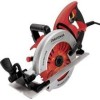Craftsman 28195 Product Manual - Page 22
Fig. 3. Always
 |
View all Craftsman 28195 manuals
Add to My Manuals
Save this manual to your list of manuals |
Page 22 highlights
7. After completing your cut, release the trigger switch and allow the blade to come to a complete stop. Do not remove the saw from the workpiece while the blade is moving. _, DANGER: When sawing through a workpiece, the lower blade guard does not cover the blade on the underside of the workpiece (Fig. 3). Always keep your hands and fingers away from the cutting area. Any part of your body coming in contact with the moving blade will result in serious injury. MAKING CROSS CUTS AND RIP CUTS ,_ WARNING: Always securely clamp and support the workpiece. Always maintain proper control of the saw. Failure to clamp and support the workpiece and loss of control of the saw could result in serious injury. WARNING: Always maintain proper control of the saw to make sawing safer and easier. Loss of control of the saw could cause an accident resulting in possibly serious injury. 1. Always use your saw with your hands positioned correctly (Fig. 11). Fig. 11 2. When making cross or rip cuts, align your line of cut with the left side of the notch by the 0 ° indicator. (Fig. 11 a). 3. Since the thicknesses of blades vary, make a trial cut in scrap material along the guideline to determine how much, if any, you should offset the blade from the guideline to allow for the kerf of the blade and make an accurate cut. INTEG RATED CROSSCUT RULER Fig. 11a i i,_ Line of Cut u_ u u, 0 ° Indicator A ruler for measuring cross cuts is marked along the front of the saw base. MAKING RIP CUTS Always use a guide when making long or wide rip cuts with your saw. You can use either a straight edge or use the edge guide that was included with your saw. 28195 Manual_Revised_07-0623 Page 22















